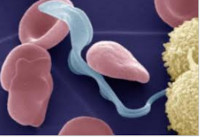Extracts of Telfeiria occidentalis as an Alternative Treatment for Trypanosoma brucei Infection in Mice
DOI:
https://doi.org/10.26538/tjdr/v2i3.2Keywords:
induced mice, Alternative drug, Telfairia occidentalis, Trypanosoma bruceiAbstract
Purpose: Historically, plants have been used to cure parasite illnesses, such as infections caused by Trypanosoma brucei. Using in vivo techniques, this study evaluated the antitrypanosomal properties of methanolic extracts of Telfairia occidentalis (Family Cucurbitaceae).
Method: Mice were infected with 0.1 ml of blood containing roughly 1 × 10³ trypanosomes for the in vivo study. Blood samples were drawn, smeared, stained with 10% Giemsa dye, and seen under a microscope over the course of seven days. Extracts were added, incubated for 10 to 15 minutes, and then observed at concentrations of 0.1, 0.01, and 0.001 mg/ml. Before, during, and after a seven-day oral treatment, haematological parameters were tracked. With no discernible negative effects (P > 0.05).
Results: The methanolic extract of Telfairia occidentalis (TOM) shows remarkable efficiency in maintaining and re-establishing normal physiological functioning in the infected mice. Fifteen bioactive components were found in the methanolic extract of Telfairia occidentalis leaves using gas chromatography-mass spectrometry (GC-MS) analysis. Among the other bioactive compounds discovered, oleic acid accounted for the largest percentage at 42.26 per cent, followed by propanoic acid (12.98 per cent) and docosanoic acid (1.18 per cent). Because of its efficacy and few side effects.
Conclusion: The study emphasises Telfairia occidentalis methanolic extract as a possible treatment for trypanosomiasis. These results provide credence to its possible use in the treatment of this parasite illness. To guarantee safety and therapeutic success, it is crucial to optimise extraction techniques and dosages, as evidenced by the toxicity and reduced efficacy seen in the moderate dosage concentration.
Downloads
References
1. Abdulsalami H, Daudu YO, Adabara NU, Hamzah RU.Antisalmonellal Activity and GC-MS Analysis of Piliostigma thonningii leaf extract. AROC in Nat. Prod. Res..2022:2(2): 01-09.doi.org/10.53858/arocnpr02020109
2. Airaodion AI, Ibrahim AH, Ogbuagu U, Ogbuagu EO, Awosanya OO, Akinmolayan JD,Adekale OA. Evaluation of phytochemical content
and antioxidant potential of Ocimum gratissimum and Telfairia occidentalis leaves. Asian J. of Res. in Med. and Pharma. Sci.,2019; 7(1), 1-11 DOI: 10.97 34/AJRIMPS/2019/v7i130110
3. Ajuru MG, Williams LF, Ajuru G. Qualitative and quantitative phytochemical screening of some plants used in ethnomedicine in the Niger Delta region of Nigeria. J. of food and Nutri. Sci.,2017;5(5), 198-205. doi: 10.11648/j.jfns.20170505.16
4. Altamura F, Rajesh Catta‐Preta CM, Moretti NS, Cestari I.The current drug discovery landscape for trypanosomiasis and leishmaniasis: Challenges and strategies to identify drug targets. Drug development research. 2022;83(2), 225-252.
5. Atawodi SE, Ameh DA, Ibrahim S, Andrew JN, Nzelibe HC, Onyike EO, Sallau AB. Indigenous knowledge system for treatment of trypanosomiasis in Kaduna state of Nigeria. J.of Ethno., 2002;79(2), 279-282.
6. Edeoga HO, DE. Okwu, BO. Mbaebie, Phytochemical Constituents of some Nigerian medicinal plants. Afr. J. of Biotec., 2005; 4 (7), 685-688
7. I El-NashaY,Shetta ND. Mutagenic Effects of Sodium Azide and Diethyl Sulphate on the Growth of Leucaena Trees (Leucaena leucocephala Lam.) Under Field Conditions. Alexandria Sci. Exch. J. 2015;(36)197-205.
8. Garrod G, Adams ER, Lingley JK, Saldanha I, Torr SJ, Cunningham LJ A pilot study demonstrating the identification of Trypanosoma brucei gambiense and T. b. rhodesiense in vectors using a multiplexed high-resolution melt qPCR. PLoS Negl Trop Dis.. 2020; 14:e0008308. doi.org/10.1371/journal.pntd.0008308
9. Kumar GS, Jayaveera KN, Kumar CK, Sanjay UP, Swamy, BM, and Kumar, DV. Antimicrobial effects of Indian medicinal plants against acne-inducing bacteria. Tropical J. of Pharma. Res., 2020; 6(2), 717-723.
10. Mwangi KW. Gene Co-expression Network of Trypanosoma brucei Developmental Stages in the Tsetse Fly Vector Glossina morsitans (Doctoral dissertation, JKUAT-COHES) 2022.
11. Parekh J, Chanda S. In vitro antimicrobial activity and phytochemical analysis of some Indian medicinal plants. Turkish J. of Biol.,2007; 31(1), 53-58
12. Oloyed OI. Chemical profile of unripe pulp of Carica papaya. Pakistan J. of Nutri.,,2005; 4, 379-381.
13. Omowaye OS Abah OO. Agada BE Assessing the Parasitic Infestation of fresh Fruits Int’and Old Markets Lokoja, Kogi State,Nigeria. Salem University J. of Life Sci., 2020:Vol.(2).194-104
14. Singleton, VL. Orthofer R. Lamuela-Raventos, RM. Analysis of total phenols and other oxidation substrates and antioxidants by means of Folin-Ciocalteu reagent. 14. Methods in Enzymology, 1999; 299, 152-178.
15. Sofowora A. Screening plants for bioactive agents. Medicinal Plants and Traditional Medicinal in Africa. 2nd Ed. Spectrum Books Ltd, Sunshine House, Ibadan, Nigeria, 1993; 134-156.
16. Tiberti N, Longoni SS, Combes V, Piubelli C. Host-Derived Extracellular Vesicles in Blood and Tissue Human Protozoan Infections. Microorganisms. 2023; 11(9), 2318
17. Xu B, Chang SK. Phytochemical profiles and health-promoting effects of cool-season food legumes as influenced by thermal processing. J. of Agri. and food chem., 2009; 57(22), 10718 -10731.
18. Zou Y, Mason MG, Botella JR. Evaluation and improvement of isothermal amplification methods for point-of-need plant disease diagnostics. PLos 2020;One. 15:e0235216.

Published
Issue
Section
License

This work is licensed under a Creative Commons Attribution-NonCommercial-ShareAlike 4.0 International License.




